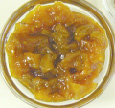What is ‘chutney’?
‘Chutney’ is a relish-type condiment; its increasing popularity reflects the inclusion of ethnic world cuisines in the Western diet.
The term ‘chutney’ includes several different varieties of sauce-type foods, drawn from traditional East Indian cuisine. The main ingredient may be an herb such as cilantro or mint; a flavoring ingredient such as coconut, onion, ginger, tamarind; or, in the most common form, chopped fruit or vegetables, simmered with spices, onion, sugar and vinegar. Fruit-based chutneys are usually cooked, then canned or refrigerated. Other chutneys like cilantro, onion, coconut, etc. are usually eaten fresh, with minimal, if any, cooking.
Fruit chutneys are most commonly available and varieties include mango, apple, apricot, cranberry, date, papaya, peach, pear, pineapple, plum, tomato and mixed fruit, to which raisins and nuts may be added to complement the texture. The result is a sweet-sour-spicy-hot versatile blend—an adventure for the taste buds.
Are there special spices commonly used in fruit chutney?
Chili powder or red pepper flakes are most common, but others include ginger (usually ground or chopped fresh ginger), garlic, turmeric, and curry powder (a mixture of ground spices like cardamom, cinnamon, cloves, coriander seed, cumin, fenugreek, mustard seed, nutmeg). Other seasonings may include salt, pepper, sugar, tamarind paste, vinegar and lemon juice.
 |
How is chutney used? Chutney is a perfect accompaniment to East Indian food; however, it can also be used as a side dish, sandwich spread, dip, an accompaniment to cheese and crackers, or as an ingredient to enhance the flavor of everyday dishes like chicken salad or casseroles. |
What helps preserve the chutney?
Several different factors contribute to the ‘preserved’ nature of this product:
- The acidity (low pH) of the chutney prevents growth of several spoilage and pathogenic bacteria, molds and yeasts. This acidity is derived from the added vinegar and the natural acids of the fruit.
- Cooking the mixture to concentrate it lowers available moisture that is needed for microbial growth. The cooking step also kills most microorganisms that may be present.
- Processing the filled jars in a canner uses additional heat to kill spoilage organisms that might contaminate the product as jars are filled and to produce a vacuum seal for later storage. If the two-piece canning lid is applied correctly, air is driven out of the headspace while the jars are in the canner and a vacuum seal is formed upon cooling. For most chutneys, a boiling water canning process is adequate, but other foods may require a pressure process.
- During storage in the sealed jar, oxygen and additional microbial contamination is kept from the product. Too much oxygen left in the jar will cause interactions with food components that lead to quality losses (for example, undesirable changes in color, texture, and flavor).
What problems could arise from improper preparation and processing of chutney?
If the cooking and canning steps are improperly carried out, spoilage microorganisms could grow, leading to product loss. In a worst-case scenario, specifically if the product is not acidified sufficiently (below pH 4.6), and not heat-processed adequately, pathogenic bacterial spores may survive, germinate and form toxin on room temperature storage – such as spores of the potentially fatal Clostridium botulinum. Also, if air is not excluded, physical and chemically-induced quality deterioration of the product may occur.
Where can I find recommended procedures for home-canned chutney?
Our tested mango chutney recipe is available at this website:
nchfp.uga.edu/how/pickle/chutneys/mango-chutney
Since chutneys are essentially pickled condiments, all of our selections are found with pickled products, at this website:
nchfp.uga.edu/how/pickle/chutneys
Where can I get more information on canning and preserving?
The National Center for Home Food Preservation has several online factsheets and resources on safe home food-preservation. This publication is a good starting point: http://www.uga.edu/nchfp/publications/publications_usda.html
In particular, this chapter provides general information for the novice food preserver: http://www.uga.edu/nchfp/publications/usda/utah_can_guide_01.pdf or http://www.uga.edu/nchfp/how/can_home.html
Refer to this factsheet for information on mangoes, such as how to cut and prepare the fruit: The Mango - A Tropical Treat
Tips:
- When cooking with vinegar, lemon juice or acid foods, use a stainless steel stockpot. This prevents leaching of metal into the food, and pitting of the vessel which might occur with other metals such as aluminum and cast iron.
- Caution: Handling green mangoes may irritate the skin of some people in the same way as poison ivy. (They belong to the same plant family.) To avoid this reaction, wear plastic or rubber gloves while working with raw green mango. Do not touch your face, lips or eyes after touching or cutting raw green mangoes until all traces are washed away.
Prepared by Elaine M. D'Sa, Ph.D., Research Coordinator with the National Center for Home Food Preservation, Department of Foods and Nutrition, College of Family and Consumer Sciences, The University of Georgia, Athens. November 2005.
Images are courtesy of the National Center for Home Food Preservation, The University of Georgia, Athens, GA.
This material is based upon work supported by the Cooperative State Research, Education, and Extension Service, U.S. Department of Agriculture, under Agreement No. 00-51110-9762.
Document Use:
Permission is granted to reproduce these materials in whole or in part for educational purposes only (not for profit beyond the cost of reproduction) provided the authors and the University of Georgia receive acknowledgment and this notice is included:
Reprinted with permission of the University of Georgia. E. D'Sa. 2005. Preservation Principles in Chutney. Athens, GA: The University of Georgia, Cooperative Extension Service.
References to commercials products, services, and information is made with the understanding that no discrimination is intended and no endorsement by the University of Georgia, U.S. Department of Agriculture and supporting organizations is implied. This information is provided for the educational information and convenience of the reader.